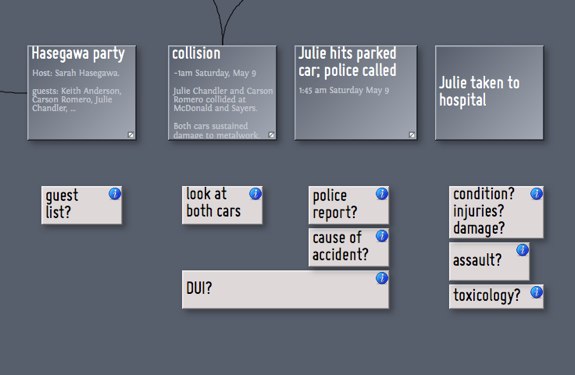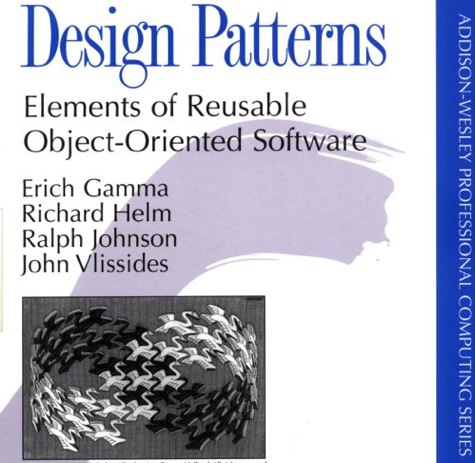Episode 4
Agendas
What Happened
Monday morning, Dan Hosmer stopped off at the Jackson Garage, where the Chandler car had been taken early Sunday morning. Hosmer used the garage himself, and knew Madison Langdon would be working by seven. Madison was 23 going on 14, had short and shockingly red hair, was barely five feet tall, and had quietly turned the garage into a showplace business.
"Hey Dan,” she said as he climbed out of his aging Civic. “Are you mistreating my little red friend again?"
"Not this time, Ms. Langdon. I’ve been talking to Joe Romero about his son’s accident."
"Oh, it’s just a headlight mount. You could replace the fender, but it’s really not that big a deal.”
“How about the Chandler car? I hear you’ve got that one, too.”
“That’s a minor mess. Hood, fender, probably a radiator. A door, too.”
"Expensive?"
"A few thousand. Take a look."
"Ouch. Any way to sort out what happened in the first accident from what happened in the second?"
"I figure the front-end damage is the second accident, where she went into someone’s mailbox. Which, unfortunately for her, was anchored in concrete. So the dent in driver’s side door, I expect, is the first accident – and your client’s headache."
"Why headache?"
"Looks to me like the car was stopped when it was hit."
"Oh."
"Must've been dead slow, or the airbags would’ve gone. And I’ve got no idea how the windshield broke, or why the glove compartment got bashed."
"I thought there were no passengers."
"So did I. But something hit that glove compartment pretty hard."
By the time Hosmer reached the office, there was already a healthy stack of messages. Tuesday’s zoning hearing was going to be postponed. Irv Star wanted to talk about his kids’ trust. And Grant Woodson had called.
“Hello, Officer Woodson," Hosmer said when he got through. “What can I do for the Bellvale police this morning?"
"I don’t know, counselor. I’m worried about those pills."
"Julie Chandler’s?"
"Yeah. On the floor of the car."
"Are you saying that I should be worried about them?"
"No idea. But I’d really like to know what those kids thought they were taking during that party. We’ll get the ID on those pills from the lab, but it would be nice to know who brought them."
"You could ask Ms. Chander."
"’What pills?’ she says."
As soon as Hosmer got off the phone, he scheduled a staff conference. Whatever this was, it was going to get complicated fast.
Previously in The Romero File

How We Map It
Taking stock, it seems natural to place the events of the previous night in sequence across the map. Beneath each event, we list some issues for investigation and follow-up.
The issues we want to pursue all share a common Prototype, which we call task; this gives them a uniform appearance and will make it easier, in the future, to ask questions like “what open tasks need to be addressed?” or “which tasks is Jim working on?”
We list the tasks vertically, beneath one of the events to which it pertains. This informal rhythm is visually pleasing, but it also helps keep tasks organized and makes it easy to scan lists of related tasks while providing a reminder of why we’re pursuing a document or fact. But this informal data structure won’t get in our way if a task doesn’t fit; if a list of tasks becomes too long we can use two columns, and tasks that don’t fit into this scheme can be placed anywhere we like.
For example, might Ms. Chandler have been driving under the influence of alcohol or another intoxicant? The police are interested in the cause of the second accident, in which our client was not involved. But, if she were intoxicated at the time of the first accident, she might be responsible for the cost of repairing the Romero’s car, and our client might be less liable for damage to the Chandler’s car sustained in the first accident.
To show we’re interested in the DUI issue for both accidents, we can make a long note that bridges both lists. Alternatively, we could make an alias of the note about DUI, and place the original in one list and the alias in the other. Or, we could decide to have two separate notes, DUI accident 1 and DUI accident 2; it seems unlikely that Julie Chandler would have been sober at the time of the first accident and intoxicated an hour later, but it would be good to know how Miss Chandler spent the time between the accidents.
The array of tasks beneath the events is a natural focus for the upcoming meeting. Someone will need to chase down the guest list. Someone will need to get an update on the medical situation. And while the outlines of the case (if there is one) remain muddled, this might be a good time to review dram shop liability issues.
R&D
Recognizing the importance of the informal, visual pairing of different elements — here, events and tasks — was the big contribution of Cathy Marshall’s VIKI. Indeed, VIKI went further than Tinderbox in trying to recognize composite objects from regular patterns observed in the map. See also H. Hsieh and F. Shipman, "VITE: A Visual Interface Supporting the Direct Manipulation of Structured Data Using Two-Way Mappings", Proceedings of ACM Conference on Intelligent User Interfaces 2000, pp. 141-148.
Among the most important intellectual developments of the 1990’s was understanding how patterns of connection between computational objects form a fluid but informative framework for thinking about complex systems. Erich Gamma, et al., Design Patterns: Elements of Reusable Object-Oriented Software (Reading, MA: Addison-Wesley, 1995).

